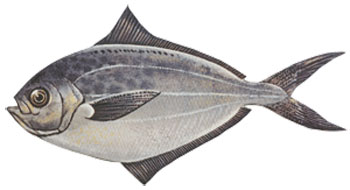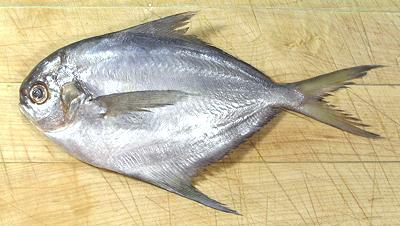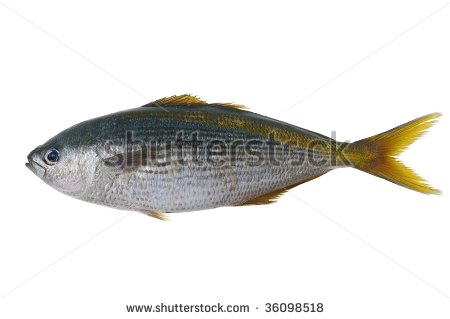
Peprilus triacanthus
FAMILY
Stromateidae
TAXONOMY
Stromateus triacanthus Peck, 1804, New Hampshire, United
States.
OTHER COMMON NAMES
English: American butterfish; French: Stromatй fossette; Spanish:
Palometa pintada.
PHYSICAL CHARACTERISTICS
Length about 11.8 in (30 cm). Body thin and deep, with short
head and blunt snout. Single dorsal fin is taller shortly posterior
to its origin, with 2–4 spines and 40–48 soft rays (II–IV,
40–48); pectoral fins moderately elongate with 1–22 fin rays;
22–25 gill rakers; lateral-line scales 96–105; anal fin almost as
long as dorsal fin, with 3 spines and 37–44 rays; caudal fin
deeply forked with slightly greater lower lobe. Pelvic fins absent.
Color grayish blue above and silvery on sides, with many
irregular dark spots laterally.
DISTRIBUTION
Western Atlantic Ocean, from off South Carolina, United
States, to Nova Scotia (sometimes as a stray off the coast of
Newfoundland); also further south to the coast of Florida,
United States, in deeper water, as well as in the Gulf of Mexico.
HABITAT
Continental shelf; found pelagically or demersally in waters as
deep as 600 ft (183 m), usually over sandy bottoms. May venture
into shallow bays and estuaries.
BEHAVIOR
Little is known concerning
BEHAVIOR
other than reproduction.
During the first year may live in association with jellyfishes or
freely, but forms schools as adults. Migratory patterns are common
in consequence of water temperature. Appear seasonally
off northeastern coast of the United States, but are generally
unpredictable as to when.
FEEDING ECOLOGY AND DIET
Feeds abundantly on soft-bodied invertebrates, preferring urochordates
and mollusks. Also feeds on cnidarians, ctenophores,
Nomeus gronovii
chaetognaths, polychaetes, and crustaceans (including amphipods,
copepods, mysids, and euphausiids). Juveniles in Narraganset
Bay, Rhode Island, United States, feed heavily on
ctenophore Mnemiopsis leidyi, not by ingesting it whole but by
taking small bites. Feeding occurs both day and night. Preyed on
by some 30 species of fishes and squids, and are part of the diet
of many commercially important fishes, such as haddocks, bluefishes,
swordfishes, summer flounders, and hammerhead sharks.
REPRODUCTIVE BIOLOGY
Sexually mature between first and second years, starting about
7.1 in (18 cm) standard length (i.e., exclusive of the caudal fin).
Broadcast spawners, lack specialized courtship
BEHAVIOR
. Spawning
takes place once a year during summer months. Eggs are
buoyant, spherical, and transparent, measure some 0.03 in (0.08
cm) in diameter; include a single oil droplet. Larvae begin to
resemble adults about 0.6 in (1.5 cm), when fin rays of dorsal,
anal, and caudal fins are fully formed.
CONSERVATION STATUS
Not threatened.
SIGNIFICANCE TO HUMANS
Important commercial fishes, heavily consumed since the
1800s, and commonly caught by otter trawls, gill nets, and
other means. In the early 2000s, yearly catches averaged under
4,921 tons (5,000 t), but in 1973 close to 19,684 tons (20,000 t)
were landed. The flesh is considered to be very delicious and
“melt-in-your-mouth,” which is reflected in the common
name.
Photo Gallery of - Butterfish





 Animalia Life
Animalia Life